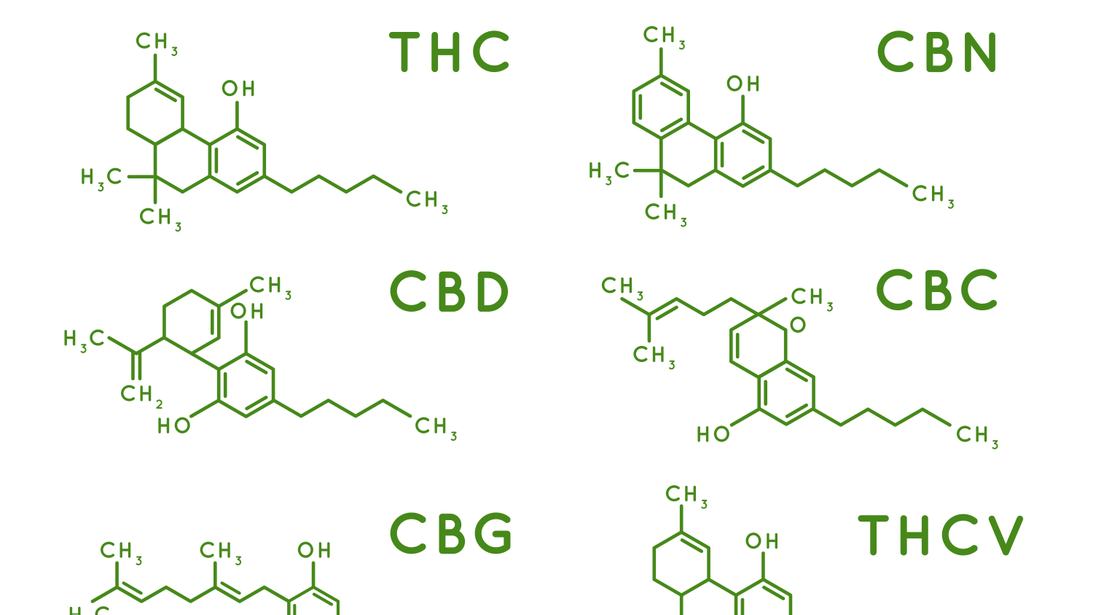Differences between CBN, CBG and CBC
Here's a look at three other cannabinoids you may have heard of.

Are there any differences between cannabinoids such as CBN, CBG, and CBC?
The short answer is yes there are differences, however, the science is still emerging and really in its infancy with the majority of (limited) relevant work in the academic literature consisting of animal studies (for example Rock et al., 2011).
Most people with an understanding of the genus cannabis sativa are familiar with the two most prominent cannabinoids in the majority of cannabis strains, namely tetrahydrocannabinol or THC, which is the phytocannabinoid responsible for intoxication and cannabidiol or CBD, which is currently generating huge interest among medical cannabis researchers. However, according to the latest count, there are 104 cannabinoids and 441 non-cannabinoid compounds in the cannabis plant (ElSohly & Waseem, 2014). How these and other cannabinoids interact is known as the entourage effect (Russo, 2011). However, evidence is also slowly emerging that independent cannabinoids can be associated with beneficial outcomes in clinical environments (Mechoulam, 2006; Pertwee, 2005).
Let’s now take a brief look at the minor cannabinoids of cannabinol (CBN), cannabigerol (CBG), and cannabichromene (CBC).
Cannabinol (CBN): When cannabis is harvested a number of chemical reactions take place that transform cannabinoids naturally. For example, under the influence of heat, the process of ‘decarboxylation’ transforms THCA to THC, which is responsible for intoxication (THCA is non-intoxicating however more on that in later segments). CBN results from the degradation of THC in the presence of oxygen and UV light, or if we want to say it more clearly the oxidation of THC transform it to CBN (Meijer, 2014).
In general, it has been found that CBN binds less effectively than THC to CB1 receptors in the endocannabinoid system (Pertwee & Cascio, 2014). Nonetheless some therapeutic benefits have been associated with CBN most notably including as a sedative with claims that “2.5 – 5 mg of CBN has the same level of sedation as a mild pharmaceutical sedative, with a relaxed body sensation similar to 5mg to 10mg of diazepam” (Steep Hill Labs, 2017), although the clinical evidence on this is far from conclusive with the strongest evidence dating back to the 1970s and 80s.
Cannabigerol (CBG): CBG was the first compound isolated from cannabis resin in a pure form (Gaoni & Mechoulam, 1964). There remains relatively little research into the therapeutic potential of CBG, however recent research has indicated some potential in regards to the regulation of vomiting and nausea (Rock et al., 2011). Furthermore, it has been suggested that both CBN and CBG are associated with limiting inflammation associated with skin disorders such as psoriasis (Oddi & Maccarrone, 2014) From the limited evidence available on this cannabinoid there is a suggestion that CBG and CBD may oppose each other at specific receptor sites within the endocannabinoid system.
Cannabichromene (CBC): Similar to the other minor cannabinoids described above, there have been relatively few studies with a focus on the pharmacological effects of CBC. There is some evidence that CBC has analgesic properties when administered at high doses, although the main therapeutic potential for CBC appears to be when administered in conjunction with other cannabinoids. For example, a possible synergism between CBC and THC has been suggested (Costa & Comelli, 2014).
References:
- Costa, B., & Comelli, F. (2014). Pain. In R. Pertwee (Ed.), Handbook of Cannabis. New York, NY: Oxford University Press.
- ElSohly, M., & Waseem, G. (2014). Constituents of cannabis sativa. In R. Pertwee (Ed.), Handbook of Cannabis. New York, NY: Oxford University Press.
- Gaoni, Y., & Mechoulam, R. (1964). Structure and synthesis of cannabigerol, a new hashish constituent. Proceedings of the Chemical Society(82).
- Mechoulam, R. (2006). Cannabinoids as Therapeutics. In Milestones in Drug Therapy. Basel, Switzerland: Birkhäuser Basel.
- Meijer, E. (2014). The chemical phenotypes (chemotypes) of cannabis. In R. Pertwee (Ed.), Handbook of Cannabis. New York, NY: Oxford University Press.
- Oddi, S., & Maccarrone, M. (2014). Phytocannabinoids and skin disorders. In R. Pertwee (Ed.), Handbook of Cannabis. New York, NY: Oxford University Press.
- Pertwee, R. (2005). Cannabinoids. Dordrecht: Dordrecht : Springer-Verlag Berlin and Heidelberg GmbH & Co. KG.
- Pertwee, R., & Cascio, M. (2014). Known pharmacological actions of delta-9 tetrahydrocannabinol and of four other chemical constituents of cannabis that activate cannabinoid receptors. In R. Pertwee (Ed.), Handbook of Cannabis. New York, NY: Oxford University Press.
- Rock, E., Goodwin, J., Limebeer, C., Breuer, A., Pertwee, R., Mechoulam, R., & Parker, L. (2011). Interaction between non-psychotropic cannabinoids in marihuana: effect of
- cannabigerol (CBG) on the anti-nausea or anti-emetic effects of cannabidiol (CBD) in rats and shrews. Psychopharmacology, 215(3), 505-512. doi:10.1007/s00213-010-2157-4
- Russo, E. (2011). Taming THC: potential cannabis synergy and phytocannabinoid‐terpenoid entourage effects. British Journal of Pharmacology, 163(7), 1344-1364.
- Steep Hill Labs. (2017). Cannabinol (CBN): a sleeping synergy. Retrieved 5/19/20129
